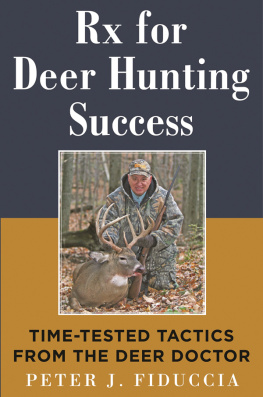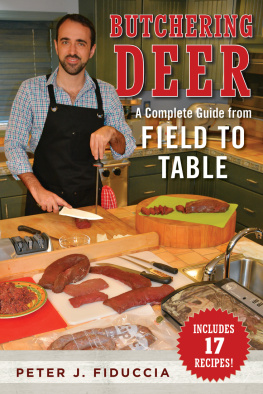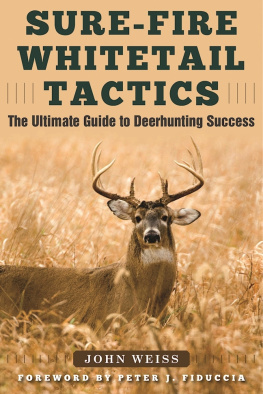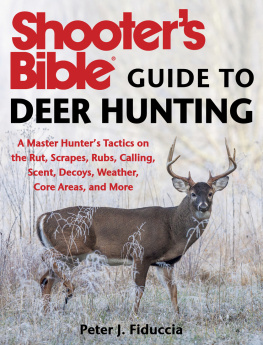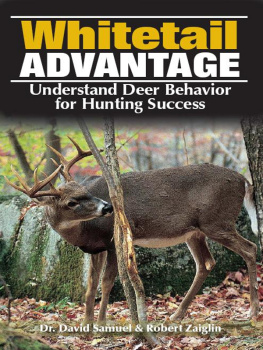Copyright 2016 by Peter J. Fiduccia
All rights reserved. No part of this book may be reproduced in any manner without the express written consent of the publisher, except in the case of brief excerpts in critical reviews or articles. All inquiries should be addressed to Skyhorse Publishing, 307 West 36th Street, 11th Floor, New York, NY 10018.
Skyhorse Publishing books may be purchased in bulk at special discounts for sales promotion, corporate gifts, fund-raising, or educational purposes. Special editions can also be created to specifications. For details, contact the Special Sales Department, Skyhorse Publishing, 307 West 36th Street, 11th Floor, New York, NY 10018 or .
Skyhorse and Skyhorse Publishing are registered trademarks of Skyhorse Publishing, Inc., a Delaware corporation.
Visit our website at www.skyhorsepublishing.com.
10 9 8 7 6 5 4 3 2 1
Library of Congress Cataloging-in-Publication Data is available on file.
Cover design by Tom Lau
Cover photo credit: Peter Fiduccia
Print ISBN: 978-1-5107-0500-5
Ebook ISBN: 978-1-5107-0501-2
Printed in China
Contents
Foreword
In his poem The Idea of Order at Key West, Wallace Stevens evokes a young woman singing as she walks along the shoreline. As daylight fades and the wind freshens, those listening to the young womans voice slowly come to understand that her song, as opposed to the turmoil of the threatening sea, lends certitude to their world. Stevenss narrator suggests that the woman has the ability to see and hear beyond the natural world and make sense out of natures chaoschaos that quails the ungifted. He explains:
She was the single artificer of the world
In which she sang. And when she sang, the sea,
Whatever self it had, became the self
That was her song, for she was the maker. Then we,
As we beheld her striding there alone,
Knew that there never was a world for her
Except the one she sang and, singing, made.
What, you may ask, does any of this have to do with deer hunting? I would answer little to nothing, but it has EVERYTHING to do with Peter Fiduccia and his artistry. Like any good researcher, Fiduccia meticulously annotates his observations. Like any prudent analyst, Fiduccia painstakingly codifies his findings. And like any gifted teacher, Fiduccia deftly disseminates his hard-won knowledge to his students. But what sets Fiduccia apart is his artistry. Fiduccia, like Stevenss singer, is an artist, and as Stevens suggests, he sees and hears more than the rest of us. By hearing and seeing more, he has the ability to find order in what may seem chaos to the common mind.
Likewise, in his short story Sonnys Blues, James Baldwins narrator comments on the challenges and rewards of the artistin this case a musician. What he says applies to artists of all stripes and to all those, like Fiduccia, who hear what the rest of us cannot.
All I know about music is that not many people ever really hear it But the man who creates the music is hearing something else, is dealing with the roar rising from the void and imposing order on it as it hits the air. What is evoked in him, then, is of another order, more terrible because it has no words, and triumphant, too, for that same reason. And his triumph, when he triumphs, is ours.
Fiduccias triumph, then, is ours, too. His gift is to hear and see beyond the abilities of the less gifted. In terms of understanding the natural worldthe world of the whitetail deerwhere others react to the chaos with confusion and wonder, Fiduccia senses order. Where others see random actions, Fiduccia perceives patterns. Where others merely surmise and hope for the best results, Fiduccia moves with confidence born of research, experience, and perceptive intuition.
Joseph Campbell, author of the Jungian-based classic of comparative mythology Hero with a Thousand Faces , makes a distinction between a celebrity and a mythic hero. In Campbells view, a celebritythink here of most popular hunting show hosts and guestsis one who sucks in light and seeks attention: Look at me! Look at me! A hero, in contrast, emits light. He or she spreads illumination and shares gifts for the common good. Such is Peter Fiduccia. Each time I pick up one of Fiduccias books or see him on YouTube, a DVD, or television, in the back of my mind I hear the strains of Aaron Coplands Fanfare for the Common Man start to play. He is the expert for the hoi polloi, the common man, the antidote to the professionals who demonstrate through their actions and attitudes that the rarified hunting experiences they recount are only for the chosen and anointed. Fiduccia is the professional for the rest of us, as he is the one who concludes in print:
Believe me, if you hunted in the areas where most of these TV hosts hunt, you would be killing the same kinds of trophy animals. I challenge any other show hosts to hunt the pressured areas of the Northeast or New England. Ill bet none of them would go home with the kind of bucks you see them kill week after week on their shows.
He even tells youwhether or not you believe itthat I am not a better deer hunter than you. In fact none of the so-called pros are. The only difference in everyday hunters and us is that we get more opportunities to hunt in prime areas.
Like that other mythic frontiersman from New York, Natty Bumppo, protagonist of James Fenimore Coopers The Leatherstocking Tales , variously known as Leatherstocking, Hawkeye, Long Rifle, Pathfinder, and, most tellingly, Deerslayer, Peter Fiduccia merits attention for his encyclopedic knowledge, the sagacity he imparts, and the ethos of stewardship through which he delivers his insights.
Perhaps the most eloquent deer hunting story in American literature is William Faulkners The Old People, the precursor to his classic The Bear. In that story, Faulkner, a deer hunter in the Delta area of his beloved Mississippi, encapsulates both the beauty of the hunt and the moral imperative incumbent upon the hunter when he describes the old hunter, Sam Fathers, instructing young Isaac McCaslin.
At first there was nothing. There was the faint, cold, steady rain, the gray and constant light of the late November dawn Then the buck was there. He did not come into sight; he was just there, looking not like a ghost but as if all the light were condensed in him and he were the source of it, not only moving in it but disseminating it, already running the antlers even in that dim light looking like a small rocking-chair balanced on his head. Now, Sam Fathers said, shoot quick and slow.
In that simple directive, shoot quick and slow, Faulkner captures the urgency of the hunt and the requisite obligations of the hunter. Perhaps not quite so lyrically expressed, but just as poignantly, Peter Fiduccias works do the same for the twenty-first century reader. Fiduccia, like Faulkner, is essential reading.
Dabney Gray , PhD
Associate Professor English
Stillman College
Tuscaloosa, AL
Acknowledgments
I grew up in Brooklyn, New York, where guys and gals graduated life with Ph.Ds in street smarts and common sense. Brooklyn sports included stick ball, Johnny-on-the-Pony, blackball (a rock hard, tiny black ball used for playing handball), and softball. Softball was ironically played in a school yard on a concreate field. Sliding into a base was optional, but somewhat expected. Although it was a tough neighborhood, I loved every second of living there, and growing up Brooklyn was the land that ultimately made me the person I am today.
In 1961, I was in my first year at Fort Hamilton High School. The Fort, as we affectionately referred to it, is located on Shore Road in Bay Ridge. It is only a few hundred yards from a bay known as The Narrows. It is the tidal strait that forms the principal channel through which the Hudson River empties in to the Atlantic Ocean. The Narrows have long been considered to be the maritime gateway to New York City, and historically has been one of the most important entrances into the harbors of the Ports of New York and New Jersey.

